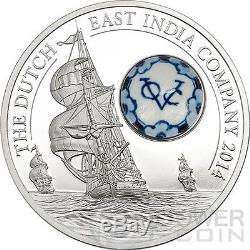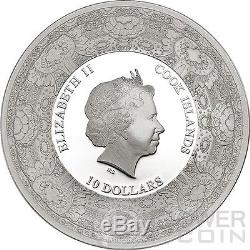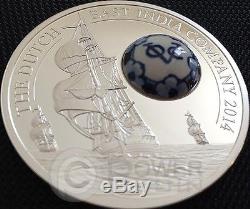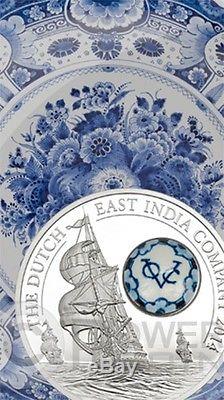ROYAL DELFT Dutch East India Company Porcelain Silver Coin 10$ Cook Islands 2014





First issue of the new series "Royal Delft". Unique concept silver 999 coin with a real Royal Delft porcelain piece inserted.
The pieces are handmade and hand painted making each coin unique. The coin is also dedicated to the Dutch East India Company.
Amazing obverse with relief of Royal Delft plate. Extremely low mintage of only 999 pieces worldwide. The obverse of the coin depicts three wonderful wooden sailing ships of the Dutch East India Company across the ocean making business between North Europe and the India known at that time. This special insert makes each coin unique.
On the top of the coin the inscription The Dutch East India Company 2014. On the reverse of the coin the effigy of her Queen Elizabeth II, the inscription Cook Islands and the face value, all around decorated with a relief of Royal Delft plate. Royal Delft and the Dutch East India Company The Koninklijke Porceleyne Fles (aka, Royal Delft) is the only remaining factory of the 32 earthenware factories that were established in Delft during the 17th century. It is known for its Delftware production, which has been active for more than 350 years, without interruption. Delft Blue started in The Netherlands around the 17th century when the VOC (the Dutch East India Company) brought the blue painted porcelain back from China.
This resulted in an inspiration for the Dutch ceramists, because this fragile porcelain was not created or seen before. For Royal Delft, it all started in 1653 when David Anthonisz van der Pieth transformed his house into an earthenware factory. Unfortunately for Van der Pieth his son was far from interested in this business and therefore he had to sell his factory real soon. This was not extremely difficult because 42 years later this industry was booming in Delft!Royal Delft already had 32 competitors in that year. Of course this was made possible by the high demand for the product and because of the decrease in beer breweries that were suited for transforming into earthenware factories. However, the most important reason, was probably that in the 17th century China faced a civil war which decreased the import of porcelain. Though, this industry did not remain as booming as in the 17th century because in the 19th century (1840 to be precise) Royal Delft was the last factory standing.
The reasons for this decrease are mostly to be found in the competition from the English Wedgwood and European porcelain industry; the eastern porcelain was cheaper and a lack of innovation amongst the Delft potters. In 1876 Joost Thooft bought the factory with the aim to revive the production of Delft Blue. He was very interested in Delft Blue and made the factory be as booming as in the 17th century again. Thooft also worked together with Leo Senf, one of the most important designers of the history of the factory. In the 17th century, Royal Delft had several factories all over Delft.
However, this was very inconvenient and in 1916 all the activities were centralised in the location which is still the current visiting address of the factory, at the Rotterdamseweg in Delft. Three years later, the company was awarded by the Royal Family the Royal in its name, which is a sign of appreciation for the contribution of Royal Delft for the Dutch Delft Blue industry. Nowadays, the relation with the Dutch Royal Family is still close. In 2003 the company celebrated its 350th anniversary which it did by launching a new line called Jubilee. The Dutch East India Company (Dutch: Vereenigde Oostindische Compagnie, VOC, "United East India Company") was a chartered company established in 1602, when the States General of the Netherlands granted it a 21-year monopoly to carry out trade activities in Asia. It is often considered to have been the first multinational corporation in the world and it was the first company to issue stock. Statistically, the VOC eclipsed all of its rivals in the Asia trade. Between 1602 and 1796 the VOC sent almost a million Europeans to work in the Asia trade on 4,785 ships, and netted for their efforts more than 2.5 million tons of Asian trade goods.By contrast, the rest of Europe combined sent only 882,412 people from 1500 to 1795, and the fleet of the English (later British) East India Company, the VOC's nearest competitor, was a distant second to its total traffic with 2,690 ships and a mere one-fifth the tonnage of goods carried by the VOC. The VOC enjoyed huge profits from its spice monopoly through most of the 17th century. Having been set up in 1602, to profit from the Malukan spice trade, in 1619 the VOC established a capital in the port city of Jayakarta and changed the city name into Batavia (now Jakarta). Over the next two centuries the Company acquired additional ports as trading bases and safeguarded their interests by taking over surrounding territory. It remained an important trading concern and paid an 18% annual dividend for almost 200 years.
Weighed down by corruption in the late 18th century, the Company went bankrupt and was formally dissolved in 1800, its possessions and the debt being taken over by the government of the Dutch Batavian Republic. The VOC's territories became the Dutch East Indies and were expanded over the course of the 19th century to include the whole of the Indonesian archipelago, and in the 20th century would form the Republic of Indonesia. The item "ROYAL DELFT Dutch East India Company Porcelain Silver Coin 10$ Cook Islands 2014" is in sale since Tuesday, October 28, 2014.This item is in the category "Coins & Paper Money\Coins\ World\Africa\Other African Coins". The seller is "powercoin_italy" and is located in Roma. This item can be shipped worldwide.
- Circulated/Uncirculated: Uncirculated
- Year: 2014
- Composition: Silver
- Country/Region of Manufacture: Cook Islands

